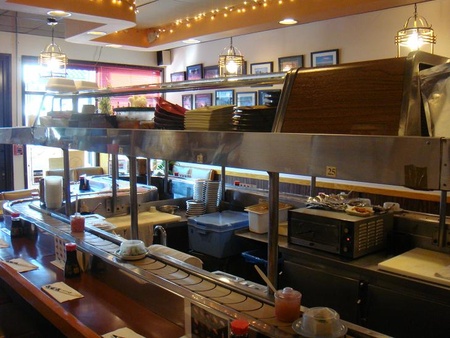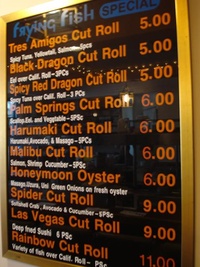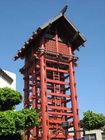As a young man, Sadahiko Akimoto met his wife Yuko when she emigrated from Japan to the U.S. after college because his mother and uncle told him that Yuko was the one he should marry. Once married, Yuko Akimoto experienced a difficult cultural adjustment, and became frustrated with feeling foreign in her new home. When the time came to start a business, Sadahiko and Yuko turned to Japanese food distribution, and started a ramen business, which was sold after only 6 months due to a lack of customers. Next, they turned to sushi, starting up Frying Fish in 1984, and taking over a business space held by the Naniwa restaurant in the Japanese Village Plaza, where they have remained. They have stayed in Little Tokyo because it was a community where Yuko Akimoto was the most comfortable, and could acclimate within the community while not feeling like such a foreigner.
Frying Fish’s claim to fame is being the first kaiten-sushi restaurant in the United States. Kaiten-sushi is a conveyor belt system that runs around the sushi bar in the restaurant. Customers choose amongst different assortments of sushi on color-to-price coordinated plates, without having to place an order. Mr. Akimoto says his motivation for the conveyor belt had nothing to do with novelty, and he cites two reasons why he chose to make their restaurant unique from the traditional sushi restaurant. The first reason was good merchandising: customers can see the real thing, and not just a picture, and determine if the sushi is fresh or not as it passes by on the belt. The second was savings with labor for the restaurant and customer: whereas other restaurants of similar size normally require three to four waitresses and chefs each, Mr. Akimoto only needs to employ one waitress and two chefs total at their 29-seat restaurant. Customers also save labor since they only need to reach over and grab whatever they want or whatever looks good.
When Frying Fish first opened, their menu consisted of traditional sushi dishes floating around a (conveyor) belt. However, as non-traditional styles of sushi became more and more popular at other sushi restaurants, American customers started to take interest. While Inari sushi is a very popular item with young people in Japan, it was not the same case in America. He realized that American tastes are different and began to study his customer’s likes and dislikes in order to expand his menu to accommodate changing trends and tastes. Mr. Akimoto developed many of the popular rolls displayed on the restaurant wall and in their hand held menus. He based these rolls on his observations of what his customers liked at the time. He even claims to have made (for his friend) the first version of the California Roll using an avocado grown in his backyard. He says the most popular item in their restaurant today is usually the Spanish Mackerel or the Salmon.

Kaiten-sushi conveyor belt in Frying Fish. Frying Fish has the claim to fame of having the first Kaiten Sushi restaurant in the United States.
Frying Fish is truly a business of and for Little Tokyo, and the Akimoto family is without a doubt a family that is as important to Little Tokyo as their restaurant. They both love and are active in the community and want to encourage more Japanese residents to come back to Little Tokyo and keep its traditions alive. They are living representatives of how Little Tokyo has evolved over the years and the people that have inhabited it for almost a century. Sadahiko and Yuko Akimoto plan to stay in Little Tokyo no matter what happens with their business, and when asked about the plans for the future of the business, Mr. Akimoto exclaimed, “I couldn’t care less.” Both he and his wife are happy and comfortable in Little Tokyo, which is all that matters to him. If they were to break even on their investment, he would be happy, but that is not why they are here.
As a Sansei, or third generation Japanese American, Mr. Akimoto and his family has seen Little Tokyo evolve from its earliest beginnings to its present state. Before World War II, his family owned a distribution business across the street from the Japanese Village Plaza, where Frying Fish is located. Their business became the forerunner for JFC International Inc., a well-known Japanese food distributer. Mr. Akimoto’s uncle, Hisao Inouye, was president of JFC, which operated out of San Francisco, and was later sold to Kikkoman Co. Hisao Inouye was very active in the Japanese community in San Francisco, but often agonized over the rapid changing of the Japan Town in San Francisco. Mr. Akimoto feels a similar anguish towards the changing of Little Tokyo (in Los Angeles) today.

The menu at Frying Fish. Many of these specialty rolls were created by Mr. Akimoto in response to the different trends the restaurant’s customers portrayed.
Frying Fish and the Akimoto family are wholeheartedly a historic and important part of Little Tokyo. Mr. Akimoto can tell stories about some of the wonderful people who live and have lived side by side in Little Tokyo. People like Mrs. Haru Hashimoto, who started Mikawaya nearly 100 years ago with her husband, and came to work every day full of energy and excitement, even at 104 years old! When it comes to the development of Little Tokyo, Mr. Akimoto is like a history book, with its shifts in residents and those who influenced Little Tokyo, like Morinosuke Kajima and his efforts to improve the city.
In the 1970s, Mr. Akimoto recalls the impact on Little Tokyo made by Morinosuke Kajima, CEO of Kajima Construction. Kajima started a campaign to build up Little Tokyo. Before his campaign, many Japanese residents had moved out of Little Tokyo to other parts of the United States. However, with Kajima’s campaign, plus the emergence of an economic boom in the U.S., residents started to return, little by little. This, in turn, encouraged Japanese companies to come to the U.S. and Little Tokyo, further expanding the Japanese population and influence in the area. Unfortunately, in time, many of these companies found more convenient locations for their businesses, and moved out of the area. Since then, Little Tokyo has experienced a large influx of Korean businesses to fill the gaps left by vacant Japanese businesses, causing quite a controversy among the Japanese residents of Little Tokyo. “If Mr. Kajima were alive today and in Los Angeles, Little Tokyo may have withstood some exterior pressure, and maintained more Japanese residents in the area,” according to Mr. Akimoto.
Today, Frying Fish remains a staple in Little Tokyo and continues to draw business, even as they are beginning to remodel the Japanese Village Plaza. For the Akimoto family, the Japanese Village Plaza and Little Tokyo is where the family has settled, and they are content to stay here until the end.
** Discover Nikkei partnered with Professor Morgan Pitelka of Occidental College and his students taking the Spring 2010 seminar “Japanophilia: Orientalism, Nationalism, Transnationalism” on a meaningful community-based documentation project. The students interviewed owners of five long-time Little Tokyo businesses to create Nikkei Albums and articles.
View the Nikkei Album: Frying Fish: Little Tokyo Los Angeles
© 2010 David Minguez



